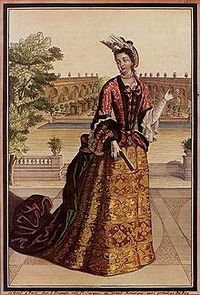Annotation:Mantua Makers Frolic (The): Difference between revisions
No edit summary |
m (Text replacement - "garamond, serif" to "sans-serif") |
||
| Line 1: | Line 1: | ||
=='''Back to [[{{BASEPAGENAME}}]]'''== | =='''Back to [[{{BASEPAGENAME}}]]'''== | ||
---- | ---- | ||
<p><font face=" | <p><font face="sans-serif" size="4"> | ||
'''MANTUA MAKER'S FROLIC, THE.''' AKA - "The Mantua Makers." English, Country Dance Tune (2/4 time). B Flat Major. Standard tuning (fiddle). AABBCC. Mantuas [http://en.wikipedia.org/wiki/Mantua_%28clothing%29] were a woman's loose gown, called a 'mantie' or mantua in the 17th and 18th centuries from the French word ''manteau.'' Alternately, it referred to a mantle fashionable in the second and third decade of the 19th century, also for women, derived from the custom of wearing a "plaid." However, since they were of open crochet or lace work, they didn't hide the face and thus were more stylish for dance assemblies. A dictionary also equates the term 'mantua-makers' with dressmakers, and says a mantua is a "woman's loose outer skirt." Mantuas were manufactured as an Edinburgh women's cottage industry in small workshops or at home. | '''MANTUA MAKER'S FROLIC, THE.''' AKA - "The Mantua Makers." English, Country Dance Tune (2/4 time). B Flat Major. Standard tuning (fiddle). AABBCC. Mantuas [http://en.wikipedia.org/wiki/Mantua_%28clothing%29] were a woman's loose gown, called a 'mantie' or mantua in the 17th and 18th centuries from the French word ''manteau.'' Alternately, it referred to a mantle fashionable in the second and third decade of the 19th century, also for women, derived from the custom of wearing a "plaid." However, since they were of open crochet or lace work, they didn't hide the face and thus were more stylish for dance assemblies. A dictionary also equates the term 'mantua-makers' with dressmakers, and says a mantua is a "woman's loose outer skirt." Mantuas were manufactured as an Edinburgh women's cottage industry in small workshops or at home. | ||
[[File:mantua.jpg|200px|thumb|left|Comtesse de Mailly wearing a mantua, 1698 (Wikipedia)]] | [[File:mantua.jpg|200px|thumb|left|Comtesse de Mailly wearing a mantua, 1698 (Wikipedia)]] | ||
</font></p> | </font></p> | ||
<br> | <br> | ||
<p><font face=" | <p><font face="sans-serif" size="4"> | ||
The melody was printed in John Johnson's '''Two Hundred Favourite Country Dances''', vol. 8 (London, 1758), David Rutherford's '''Compleat Collection of 200 Country Dances''', vol. 2 (London, 1760), Straight and Skillern's '''Two Hundred and Four Favourite Country Dances''', vol. 1 (London, 1775), as well as Charles and Samuel Thompson's 1765 collection. The melody is also contained in the large dance music manuscript collection of Northumbrian musician William Vickers (1780). | The melody was printed in John Johnson's '''Two Hundred Favourite Country Dances''', vol. 8 (London, 1758), David Rutherford's '''Compleat Collection of 200 Country Dances''', vol. 2 (London, 1760), Straight and Skillern's '''Two Hundred and Four Favourite Country Dances''', vol. 1 (London, 1775), as well as Charles and Samuel Thompson's 1765 collection. The melody is also contained in the large dance music manuscript collection of Northumbrian musician William Vickers (1780). | ||
</font></p> | </font></p> | ||
<br> | <br> | ||
<p><font face=" | <p><font face="sans-serif" size="4"> | ||
''Source for notated version'': | ''Source for notated version'': | ||
<br> | <br> | ||
<br> | <br> | ||
</font></p> | </font></p> | ||
<p><font face=" | <p><font face="sans-serif" size="4"> | ||
''Printed sources'': Straight and Skillern ('''Two Hundred and Four Favourite Country Dances, vol. 1'''), c. 1775; No. 169, p. 85. Thompson ('''Compleat Collection of 200 Favourite Country Dances, vol. 2'''), 1765; No. 7. | ''Printed sources'': Straight and Skillern ('''Two Hundred and Four Favourite Country Dances, vol. 1'''), c. 1775; No. 169, p. 85. Thompson ('''Compleat Collection of 200 Favourite Country Dances, vol. 2'''), 1765; No. 7. | ||
<br> | <br> | ||
<br> | <br> | ||
</font></p> | </font></p> | ||
<p><font face=" | <p><font face="sans-serif" size="4"> | ||
''Recorded sources'': <font color=teal></font> | ''Recorded sources'': <font color=teal></font> | ||
</font></p> | </font></p> | ||
Revision as of 14:19, 6 May 2019
Back to Mantua Makers Frolic (The)
MANTUA MAKER'S FROLIC, THE. AKA - "The Mantua Makers." English, Country Dance Tune (2/4 time). B Flat Major. Standard tuning (fiddle). AABBCC. Mantuas [1] were a woman's loose gown, called a 'mantie' or mantua in the 17th and 18th centuries from the French word manteau. Alternately, it referred to a mantle fashionable in the second and third decade of the 19th century, also for women, derived from the custom of wearing a "plaid." However, since they were of open crochet or lace work, they didn't hide the face and thus were more stylish for dance assemblies. A dictionary also equates the term 'mantua-makers' with dressmakers, and says a mantua is a "woman's loose outer skirt." Mantuas were manufactured as an Edinburgh women's cottage industry in small workshops or at home.

The melody was printed in John Johnson's Two Hundred Favourite Country Dances, vol. 8 (London, 1758), David Rutherford's Compleat Collection of 200 Country Dances, vol. 2 (London, 1760), Straight and Skillern's Two Hundred and Four Favourite Country Dances, vol. 1 (London, 1775), as well as Charles and Samuel Thompson's 1765 collection. The melody is also contained in the large dance music manuscript collection of Northumbrian musician William Vickers (1780).
Source for notated version:
Printed sources: Straight and Skillern (Two Hundred and Four Favourite Country Dances, vol. 1), c. 1775; No. 169, p. 85. Thompson (Compleat Collection of 200 Favourite Country Dances, vol. 2), 1765; No. 7.
Recorded sources:
